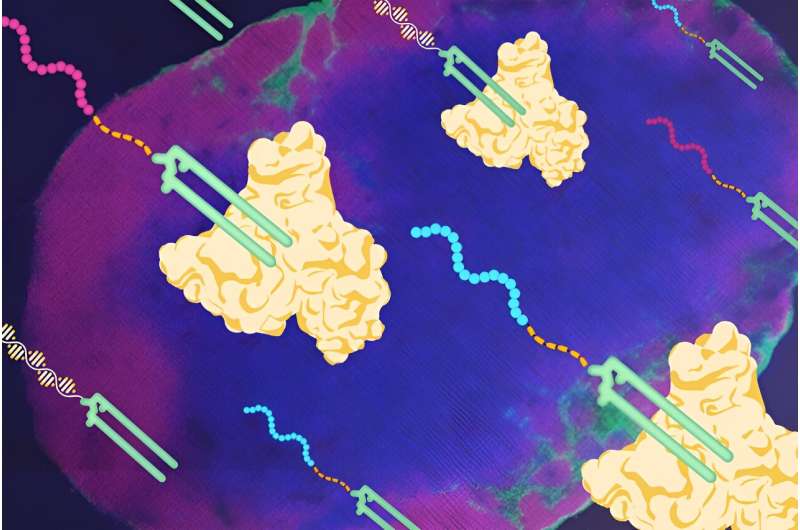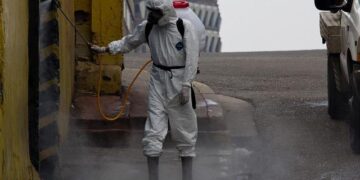
Originally developed in the laboratory of Darrell Irvine, “amphiphile” vaccines hitchhike on albumin molecules to the lymph nodes, where they teach the immune system to fight cancer. MIT spinout Elicio Therapeutics is testing vaccines based on the technology in clinical trials, with promising early results in treating pancreatic cancer. Credit: Bendta Schroeder
Therapeutic cancer vaccines are an appealing strategy for treating malignancies. In theory, when a patient is injected with peptide antigens—protein fragments from mutant proteins only expressed by tumor cells—T cells learn to recognize and attack cancer cells expressing the corresponding protein. By teaching the patient’s own immune system to attack cancer cells, these vaccines ideally would not only eliminate tumors but prevent them from recurring.
In practice, however, effective cancer vaccines have not materialized, despite decades of research.
“There has been a lot of work to make cancer vaccines more effective,” says Darrell Irvine, a professor in the MIT departments of Biological Engineering and Materials Science and Engineering and a member of the Koch Institute for Integrative Cancer Research at MIT. “But even in mouse and other models, they typically only provoke a weak immune response. And once those vaccines are tested in a clinical setting, their efficacy evaporates.”
New hope may now be on the horizon. A vaccine based on a novel approach developed by Irvine and colleagues at MIT, and refined by researchers at Elicio Therapeutics, an MIT spinout that Irvine founded to translate experiments into treatment, is showing promising results in clinical trials—including Phase 1 data suggesting the vaccine could serve as a viable option for the prevention of pancreatic and other cancers.
Formulating a question
When Haipeng Liu joined Irvine’s laboratory as a postdoc almost 15 years ago, he wanted to dive into the problem of why cancer vaccines have failed to deliver on their promise. He discovered that one important reason peptide vaccines for cancer and other diseases tend not to elicit a strong immune response is because they do not travel in sufficient quantities to lymph nodes, where populations of teachable T cells are concentrated.
He knew that attempts to target peptides to the lymph nodes had been imprecise: Even when delivered with nanoparticles or attached to antibodies for lymphatic immune cells, too many vaccine peptides were taken up by the wrong cells in the tissues or never even made it to the lymph nodes.
But Liu, now an associate professor of chemical engineering and materials science at Wayne State University, also had a simple, unanswered question: If vaccine peptides did not make it to the lymph nodes, where did they go?
In the pursuit of an answer, Liu and his Irvine Lab colleagues would make discoveries crucial to trafficking peptides to the lymph nodes and developing a vaccine that provoked surprisingly strong immune responses in mice. That vaccine, now in the hands of Irvine Lab spinout Elicio Therapeutics, Inc., has produced early clinical results showing a similarly strong immune response in human patients.
Liu began with testing peptide vaccines in mouse models, finding that peptides injected in the skin or muscle generally rapidly leak into the bloodstream, where they are diluted and degraded rather than traveling to the lymph nodes. He tried bulking up and protecting the peptide vaccine by enclosing it within a micellar nanoparticle.
This type of nanoparticle is composed of “amphiphilic” molecules, with hydrophilic heads that, in a water-based solution, encase a payload attached to its hydrophobic lipid tails. Liu tested two versions, one that locked the micellar molecules together to securely enclose the peptide vaccine and another, the control, that did not. Despite all the sophisticated chemistry that went into the locked micellar nanoparticles, they induced a weak immune response. Liu was crushed.
Irvine, however, was elated. The loosely bound control micelles produced the strongest immune response he had ever seen. Liu had hit on a potential solution—just not the one he expected.
Formulating a vaccine
While Liu was working on micellar nanoparticles, he had also been delving into the biology of the lymph node. He learned that after removing a tumor, surgeons use a small blue dye to image lymph nodes to determine the extent of metastasis. Contrary to expectation raised by the dye molecule’s small molecular weight, it does not vanish into the bloodstream after administration. Instead, the dye binds to albumin, the most common protein in blood and tissue fluids, and tracks reliably to the lymph nodes.
The amphiphiles in Liu’s control group behaved similarly to the imaging dye. Once injected into the tissue, the “loose” micelles were broken up by albumin, which then carried the peptide payload just where it needed to go.
Taking the imaging dye as a model, the lab began to develop a vaccine that used lipid tails to bind their peptide chains to lymph node-targeting albumin molecules.
Once their albumin-hitchhiking vaccine was assembled, they tested it in mouse models of HIV, melanoma, and cervical cancer. In the resulting 2014 study, they observed that peptides modified to bind albumin produced a T cell response that was five to 10 times greater than the response to peptides alone.
In later work, Irvine lab researchers were able to generate even larger immune responses. In one study, the Irvine Lab paired a cancer-targeted vaccine with CAR T cell therapy. CAR T has been used to treat blood cancers such as leukemia successfully but has not worked well for solid tumors, which suppress T cells in their immediate vicinity.
The vaccine and CAR T cell therapy together dramatically increased antitumor T cell populations and the number of T cells that successfully invaded the tumor. The combination resulted in the elimination of 60% of solid tumors in mice, while CAR T cell therapy alone had almost no effect.
A model for patient impact
By 2016, Irvine was ready to begin translating the vaccine from lab bench experiments to a patient-ready treatment, spinning out a new company, Elicio.
“We made sure we were setting a high bar in the lab,” said Irvine. “In addition to leveraging albumin biology that is the same in mouse and humans, we aimed for and achieved 10-, 30-, 40-fold greater responses in the animal model relative to other gold standard vaccine approaches, and this gave us hope that these results would translate to greater immune responses in patients.”
At Elicio, Irvine’s vaccine has evolved into a platform combining lipid-linked peptides with an immune adjuvant—no CAR T cells required. In 2021, the company began a clinical trial, AMPLIFY-201, of a vaccine named ELI-002, targeting cancers with mutations in the KRAS gene, with a focus on pancreatic ductal adenocarcinoma (PDAC).
The vaccine has the potential to fill an urgent need in cancer treatment: PDAC accounts for 90% of pancreatic cancers, is highly aggressive, and has limited options for effective treatment. KRAS mutations drive 90%–95% of all PDAC cases, but there are several variations that must be individually targeted for effective treatment.
Elicio’s cancer vaccine has the potential to target up to seven KRAS variants at once covering 88% of PDAC cases. The company has initially tested a version that targets two, and Phase 1 and 2 studies of the version targeting all seven KRAS mutants are ongoing.
Data published last month in Nature Medicine from the Phase 1 clinical trial suggests that an effective therapeutic cancer vaccine could be on the horizon.
The robust responses seen in the Irvine Lab’s mouse models have so far translated to the 25 patients (20 pancreatic, 5 colorectal) in the trial: 84% of patients showed an average 56-fold increase in the number of antitumor T cells, with complete elimination of blood biomarkers of residual tumor in 24%. Patients who had a strong immune response saw an 86% reduction in the risk of cancer progression or death. The vaccine was tolerated well by patients, with no serious side effects.
“The reason I joined Elicio was, in part, because my father had KRAS-mutated colorectal cancer,” said Christopher Haqq, executive vice president, head of research and development, and chief medical officer at Elicio. “His journey made me realize the enormous need for new therapy for KRAS-mutated tumors. It gives me hope that we are on the right path to be able to help people just like my dad and many others.”
In the next phase of the PDAC clinical trial, Elicio is currently testing the formulation of the vaccine that targets seven KRAS mutations. The company has plans to address other KRAS-driven cancers, such as colorectal and non-small cell lung cancers. Peter DeMuth Ph.D. ’13, a former graduate student in the Irvine Lab and now chief scientific officer at Elicio, credits the Koch Institute’s research culture with shaping the evolution of the vaccine and the company.
“The model adopted by the KI to bring together basic science and engineering while encouraging collaboration at the intersection of complementary disciplines was critical to shaping my view of innovation and passion for technology that can deliver real-world impact,” he recalls. “This proved to be a very special ecosystem for me and many others to cultivate an engineering mindset while building a comprehensive interdisciplinary knowledge of immunology, applied chemistry, and materials science. These themes have become central to our work at Elicio.”
This story is republished courtesy of MIT News (web.mit.edu/newsoffice/), a popular site that covers news about MIT research, innovation and teaching.
Citation:
Hitchhiking cancer vaccine makes progress in the clinic (2024, February 16)
retrieved 16 February 2024
from https://medicalxpress.com/news/2024-02-hitchhiking-cancer-vaccine-clinic.html
This document is subject to copyright. Apart from any fair dealing for the purpose of private study or research, no
part may be reproduced without the written permission. The content is provided for information purposes only.
>>> Read full article>>>
Copyright for syndicated content belongs to the linked Source : Medical Xpress – https://medicalxpress.com/news/2024-02-hitchhiking-cancer-vaccine-clinic.html































